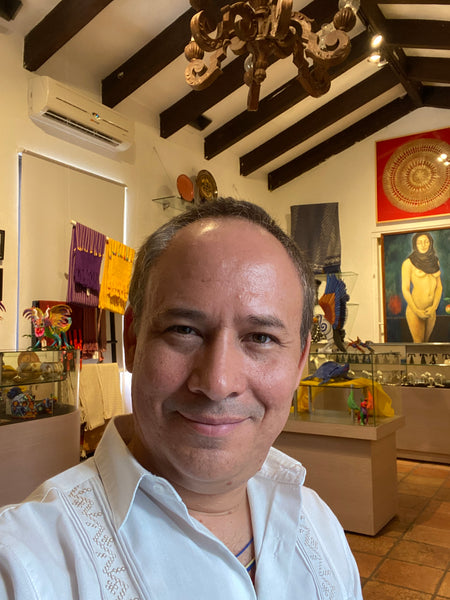Maque is a highly elaborate pre columbian technique developed by the Purépecha indigenous people in the XIVth century at the region of Michoacán, Mexico. Although this lacquer technique survived for centuries, even the independence war; it almost disappeared after the revolution war in 1910. Roads were closed, men were drafted, hundreds of thousand died and family workshops were forced to close and the tradition was almost lost.
Lacquered tray Ca 1890
The technique was recovered thanks to the research promoted by President Lázaro Cárdenas, but after a couple of decades, maque production diminished and almost disapeared due to the enormous growth of industrialised goods of the second half of the XXth century. Prior to these market fickleness, Maque products were intended as every day objects, but making each piece is a process that requires love, patience and dedication. Now, maque woodcrafts are treasured pieces for a select group of connoisseurs and collectors that care about tradition. History has cycles and now, just like 100 or 200 years ago, Michoacán and México face huge social and political challenges. Maque is still at risk. It is our belief that only trough the diffusion and promotion of this important cultural heritage Maque will have a chance to survive.

Maque Mask, Ca 1980 by renowned master, Victoriano Salgado (1920-2012)
The process
The main ingredient of the Maque is an oil extracted from the female specimens of an insect called aje (cocus axin). Collecting the insects and extracting the oil, involves a process that takes several days of an almost alchemic work with cooking, cooling down and filtering steps.
Chia oil is also used as a drying agent. Nowadays treasured for its nutritional value, chia was consumed in several ways by the ancient Mesoamerican people and used as a sacred offering to the gods.
A carbonated soil with a precise proportion of caustic lime (54.4%), magnesium (41.1%) and iron oxide (4.5%) is also very important for the preparation of the Maque. This mixture is called Tepútzchuta in Purépecha.

The base of the maque is called sisa. To prepare it, the artisan must the artisan must burn the axe grease and let the remanent drops fall into the chia oil, then he adds the Tepútzchuta.
To add colour, sieved mineral soils and vegetable pigments are incorporated, according to the desired effect.
The best wood for maque is called Aile. It has been used for centuries due to it´s hardness, which is a requisite to make a good maque piece. Once carved, each item is sanded and dried under the sunlight for several days.
To apply the maque, the artisan adds the mixture by hand, using several layers until the desired thickness is achieved. In order to obtain a well burnished look, the artist must rub the piece with his own bare hands.The piece must be left to dry for many days in order to make the lacquer strong enogh.
After this process, the artisan must carefully etch out from the previously added layer of maque, the desired decoration, let´s say for instance a flower. Then, a new layer of maque is added, this time with the desired pigments for the motif. To achieve precision ,each colour must be applied and dried out separately until the whole engraving has been finished.
Finally, the piece is rubbed with a mixture of axe and oil and cleaned with a soft cloth.
Due to the ellaborate process and the masive production of industrialized items, this technique almost disapeared during the XXth century. With your shopping, you help to preserve this art expression that dates back to pre hispanic times. Time has a special meaning for the Indigenous people. Only trough such conception of time maque can exist.
Thank you for your visit and thank you for your time.

Bibliography:
Maque, Estudio Histórico sobre un Bello Arte, Eva Maria Thiele. Instituto Michoacano de Cultura. 1982.


I’ve revisited your website several times. It seems that each time I do that, I discover something “new”. Your blog posts are wonderful and have given me new knowledge in adding to my collection of Mexican folk art.